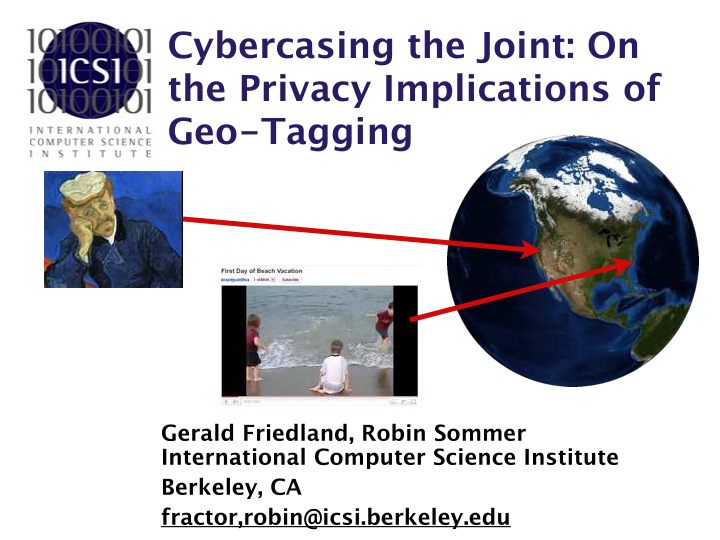



Cybercasing the Joint: On the Privacy Implications of Geo-Tagging Gerald Friedland, Robin Sommer International Computer Science Institute Berkeley, CA fractor,robin@icsi.berkeley.edu
What is Geotagging? Source: Wikipedia 2
Why Geo-Tagging? Allows easier clustering of photo and video series as well as additional services. 3
Why Geo-Tagging? Part of location-based service hype: 4
Support for Geo-Tags Social media portals provide APIs to connect geo-tags with metadata, accounts, and web content. Portal % Total YouTube (estimate) 3.0 3M Flickr 4.5 180M Allows easy search, retrieval, and ad placement. 5
Problems People are unaware of 1. geo-tagging 2. resulting inference possibilities: a. high resolution of sensors b. large amount of geo-tagged data c. easy-to-use APIs allow fast retrieval 6
Related Work “Be careful when using social location sharing services, such as FourSquare.” 7
Related Work Mayhemic Labs, June 2010: “Are you aware that Tweets are geo-tagged?” 8
Can you do real harm? • Cybercasing: Using online (location-based) data and services to mount real-world attacks. • Three Case Studies: 9
Case Study 1: Twitter • Pictures in Tweets can be geo-located • From an undisclosed celebrity we found: – Home location (several pics) – Where the kids go to school – The place where he/she walks the dog – “Secret” o ffj ce • Systematic search: picfog.com 10
Celebs unaware of Geo- Tagging Source: ABC News 11
Celebs unaware of Geotagging 12
Google Maps shows Address... 13
Case Study 2: Craigslist • Many ads with geo-location otherwise anonymized • Sometimes selling high-valued goods, e.g. cars, diamonds • Sometimes “call Sunday after 6pm” • Multiple photos allow interpolation of coordinates for higher accuracy 14
Craigslist: Real Example 15
Geo-Tagging Resolution iPhone 3G picture Google Street View Measured accuracy: +/- 1m 16
People are Unaware of Geo-Tagging “For Sale” section of Bay Area Craigslist.com: 4 days: 68729 pictures total,1.3% geo-tagged # Model # Model 414 iPhone 3G 6 Canon PowerShot SD780 287 iPhone 3GS 3 MB200 98 iPhone 2 LG LOTUS 32 Droid 2 HERO200 26 SGH-T929 2 BlackBerry 9530 20 Nexus One 1 RAPH800 9 SPH-M900 1 N96 9 RDC-i700 1 DMC-ZS7 6 T-Mobile G1 1 BlackBerry 9630 17 Table 1:
Case Study 3: YouTube • Once data is published, the Internet keeps it (in potentially many copies). • APIs are easy to use and allow quick retrieval of large amounts of data • Even simple inference algorithms (across di fg erent websites) allow for cybercasing. Can we find people on vacation in YouTube? 18
Cybercasing on YouTube Experiment: Cybercasing using the YouTube API (240 lines in Python) Location Radius Query Keywords Results Users? Query YouTube Results Time-Frame Distance Filter Cybercasing 19 Candidates
Cybercasing on YouTube Input parameters Location: 37.869885,-122.270539 Radius: 100km Keywords: kids Distance: 1000km Time-frame: this_week 20
Cybercasing on YouTube Output Initial videos: 1000 (max_res) ➡ User hull: ~ 50k videos ➡ Vacation hits: 106 ➡ Cybercasing targets: >12 21
Cybercasing on YouTube Output Initial videos: 1000 (max_res) ➡ User hull: ~ 50k videos ➡ Vacation hits: 106 ➡ Cybercasing targets: >12 22
Solutions? 23
Solutions? • Better Education • More secure default values • Blurring • Scrubbing • Privacy-preserving APIs and policies 24
Proposal: Opt-In with Choice of Accuracy Mockup of a privacy-improved iPhone dialog 25
Conclusion • Geo-location o fg ers great opportunities and we should continue to explore them • However it can pose real-world risks • Therefore, we should: • Raise the awareness on privacy issues • Discuss policies and interfaces 26
Questions? • Are you concerned? • What is a good trade-o fg between privacy and utility? • How can we design policies and APIs to implement the trade-o fg ? 27
Recommend
More recommend